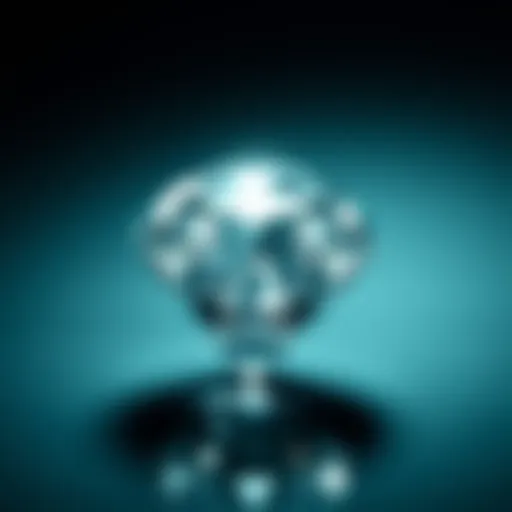The Illumination of Onyx: Light and Stone Connection


Intro
The world of onyx stone is as layered as the gemstone itself. For collectors, researchers, or even casual enthusiasts, understanding how light interacts with onyx can unlock new appreciation for its beauty and value. This guide dives into the history, identification nuances, and cultural significance of this fascinating mineral.
History and Origins
Overview of Collectibles, Rocks, and Fossils
Throughout history, people have been drawn to the beauty and mystique of onyx. From ancient civilizations to modern collectors, onyx has stood out due to its unique aesthetic. The deep colors, often characterized by rich blacks, browns, and whites, provide a captivating canvas for light. Often, it appears marbled or banded, a quality that resonates with the human eye.
Traditionally, onyx stones have been utilized for various purposes — from decorative objects to intricate carvings, and even as adornments in jewelry. Collectible stones, particularly onyx, form a sizable niche among rock and fossil enthusiasts. Each piece holds a tale, showcasing either its geological origin or the craftsmanship of its creator.
Historical Significance and Cultural Impact
The historical journey of onyx is rich and diverse. Ancient Egyptians revered it, believing in its mystical powers. They used it in amulets and ceremonial artifacts. In India, it adorned temples, while in the Roman Empire, onyx was crafted into cameos and intaglios, symbols of status and power.
Its place in artistic expression has transformed over the ages. Now, collectors appreciate onyx not merely as a rock but as a piece of history. Its presence speaks to cultural narratives; it evokes admiration and intrigue, a bridge between the past and present.
Identification and Classification
Guide to Identifying Rocks and Fossils
Identifying onyx isn’t overly complicated if you know what to look for. Here are some key attributes:
- Color: Onyx can be black, banded with white, brown, or even red.
- Translucency: Some varieties allow light to pass through, creating a stunning glow when illuminated.
- Hardness: Onyx scores between 6.5 and 7 on the Mohs scale, making it durable yet workable.
- Texture: The surface can vary from smooth to slightly pitted, which is common in natural stones.
Common Types and Variations
Collectors often encounter several variations of onyx, such as:
- Chalcedony Onyx: The most popular type, known for its smooth finish and layered bands.
- Mexican Onyx: Renowned for its bright colors and patterns, often used in decorative pieces.
- Green Onyx: This variant stands out due to its vibrant, earthy hue.
Onyx, in all its forms, brings a story behind its creation and its journey through human history. Renowned not just for their aesthetic appeal, these stones connect the dots between different cultures and eras.
In crafting this exploration, let’s not overlook the practicalities of owning onyx. As you read further, we’ll discuss care tips and display ideas to ensure that your pieces remain as radiant as the light they embrace.
Prelude to Onyx
Onyx holds a significant place in the world of gemstones, captivating collectors and enthusiasts alike. This section aims to shed light on its multifaceted characteristics, setting the stage for the intricate relationship between onyx, light, and the earth itself. Understanding onyx is not merely about its physical appeal; it's about appreciating its history, geological nature, and the role it plays in culture and design.
In this exploration, we will dive deep into what defines onyx—its unique properties and how it stands apart in the world of stones. Considerations about its formation, types, and uses are essential aspects that will enhance one’s appreciation for this remarkable gem. Notably, recognizing onyx's commercial and aesthetic value can also guide collectors in making informed choices regarding their collections.
Defining Onyx
Onyx is a striking chalcedony, a microcrystalline variety of quartz. It is characterized by its parallel bands of contrasting colors, usually alternating black and white, though it can showcase a variety of hues from deep greens to vibrant reds. This stone is often used in ornamental carvings and is well-known for its distinctive translucency. When light penetrates it, onyx can illuminate surroundings in mesmerizing ways, revealing the beauty hidden within its layers.
One might say it’s as if onyx carries a secret; the interplay between its translucency and the light creates ethereal patterns. These striking visuals often inspire artists and designers, making onyx not just a stone but an integral part of creative expression. Thus, for collectors and admirers, onyx embodies the fascinating combination of nature’s artistry and geological science.
The Geological Formation of Onyx
The formation of onyx is a tale etched into the bedrock of our planet. Typically, onyx forms in volcanic regions, where silica-rich solutions infuse into gas bubbles in lava. Over time, as cooling occurs, layers of silica solidify, resulting in the formation of the stone we admire today.
This process requires patience—millions of years can go by before the subtle beauty of onyx emerges. The unique banding is produced through variations in mineral content and the speed of crystallization, echoing the precise conditions where they are formed. This intricate formation process not only adds to onyx's geological profile but also contributes to its rarity and value in the marketplace. As such, understanding its origins can give collectors a richer context for their appreciation of this stone.
The Science of Light
Light serves as the essential medium through which the unique characteristics of onyx are expressed. To grasp the full beauty and value of onyx stones, understanding the science of light is key. It is not merely about illumination but rather the unique interplay of rays as they encounter the subtleties of this naturally occurring gem. The way light behaves around and through onyx fundamentally shapes our perception of its aesthetic qualities. In this section, we will explore the specific attributes of light, the phenomena surrounding its interactions with materials, and why these insights are crucial for collectors.
Understanding Light and Its Properties
Light, in its essence, is an electromagnetic radiation that is visible to the human eye. It travels at a blistering speed and possesses various properties that affect how we perceive everything around us. The key properties of light that are relevant in the realm of onyx include:
- Wavelength: This determines the color we see. Each different wavelength of light resonates differently with materials like onyx.
- Transmittance: Onyx, quite famously, is known for its translucent nature. This means that certain wavelengths will pass through it, altering the perceived color and vibrancy.
- Reflection and Refraction: As light hits the surface of onyx, some is reflected back while the rest bends depending on the material it is moving through. This effect creates layers of depth in the stone that can enchant collectors and enthusiasts.


Understanding light and its properties is not just an academic pursuit; it serves practical purposes for any individual looking to appreciate their onyx collection fully. The effects of mineral composition and light can significantly impact the perceived value of each piece.
The Interaction of Light with Materials
When light interacts with materials, several intriguing phenomena occur, particularly when it comes to gems. For onyx, these interactions reveal its intrinsic beauty. Here are some of the notable responses to light:
- Transmission vs. Absorption: While some stones absorb light, onyx transmits it to a degree that enhances its color. The interplay between light entering and bouncing around within the stone creates a sort of glow that captivates.
- Chroma and Saturation: Onyx can exhibit a rich palette of colors influenced largely by what light is allowed to pass through. This characteristic is essential when selecting pieces for a collection. Stones that display vibrant colors under various light settings often command higher prices.
"The beauty of onyx lies not just in its structure but in how it dances with light, creating a moment of allure that can only be appreciated through careful observation."
When you place a piece of onyx in well-thought-out lighting conditions, its depths and patterns can come alive in ways that plain sight can’t capture. For collectors, it becomes about more than just owning a stone; it’s about owning a piece of artistry shaped by the light filtering through its layers.
In summary, the science of light is pivotal in understanding onyx. This understanding enriches not only the appreciation of each piece but also informs best practices regarding its display and use in various contexts. Whether in décor or personal jewelry, knowing how to best utilize light can transform the experience and elevate the value of these exquisite stones.
For further exploration of light's properties, you might want to check out more scientific insights on Britannica or engaging discussions on platforms like Reddit.
By grasping the nuances of light’s interaction, collectors and admirers alike can truly illuminate their experience with onyx.
Onyx and Light: A Unique Relationship
The interplay between onyx and light is not just a natural phenomenon; it plays a central role in defining the character and allure of this stunning stone. As enthusiasts of rock and mineral collections are often aware, onyx's capacity to interact with light opens up an array of visual experiences that can transform any space. This relationship is integral for collectors who seek not only aesthetic beauty but also the underlying complexities that enhance the stone's value. Understanding this bond involves delving into the subtleties of translucency, color variations, and the intricate patterns that emerge when light dances upon its surface.
Translucency of Onyx
Translucency is perhaps one of the most captivating features of onyx. Unlike stones that simply absorb or reflect light, onyx offers a unique ability to allow light to pass through it. This characteristic enhances its appeal in various forms, whether utilized loosely in art pieces or structured precisely in design aspects such as backlit walls or tabletops. The translucency does not just add to the visual depth of the stone; it invites an exploration of what lies beneath each layered stratum. Collectors often find themselves enchanted by the gentle glow emitted from their pieces, especially when illuminated properly. To appreciate this quality fully, one must consider both the thickness of the onyx and the color saturation. Thinner slices of onyx exhibit a more pronounced luminescence, making them ideal for ambient lighting applications.
Color Variations and Their Interaction with Light
Onyx is known for its diverse palette, ranging from rich blacks and whites to vibrant greens and deep reds. Each color plays a distinct role in how light interacts with the stone. For example, a piece with high contrast, such as black and white banded onyx, can create dramatic effects when light filters through its layers. Conversely, more monochromatic varieties can produce a softer, more subtle glow. This variation in color affects not only aesthetics but also psychological perceptions; some hues may evoke feelings of tranquility, while others can energize a space.
Building a collection centered around color can guide how one selects pieces, especially in relation to their intended display. Using complementary colors can enhance light diffusion, creating a harmonious atmosphere. For instance, pairing light-colored onyx with warm lighting can amplify the stone's natural charm, drawing attention to its intricate design.
Reflections and Patterns: The Onyx Aesthetic
The patterns often found in onyx serve as visual narrators of the natural processes that created them. Veins and swirls, akin to abstract art, carry stories of geological transformation, merging beauty and science seamlessly. When light interacts with these complex patterns, the result can be nothing short of mesmerizing. Tactile interaction—when running fingers along the grooves and curves—adds another layer to the aesthetic experience.
In terms of design, these variations can be a game changer for architects and interior designers. By incorporating onyx into spaces—be it as countertops, accent walls, or art installations—one can turn an ordinary room into a striking display of light and shadow. The reflections create an ever-changing dialogue within the space, shifting as the light throughout the day changes, a dynamic element that draws eyes and evokes conversation.
"The magic of onyx lies in its ability to bring depth and warmth to any environment, transforming light into a visual spectacle that feels alive."
Consumers and aficionados alike should consider these aspects when curating collections. The way light and stone coalesce is not incidentally beautiful; it requires thoughtful selection, display, and maintenance to ensure that one's collection remains vibrant and impactful.
Historical Significance of Onyx
The historical importance of onyx stretches far beyond its aesthetic appeal. This stone carries a legacy that intertwines with various cultures, signifying wealth, power, and spirituality. Collectors and enthusiasts alike must understand its historical context to fully appreciate onyx's place in both the art world and personal collections. This section unearths the rich narrative behind onyx, shedding light on its use in ancient civilizations and its cultural symbolism across different cultures.
Onyx in Ancient Civilizations
In ancient times, onyx was often seen as more than just a decorative stone; it was woven into the very fabric of societal structures. In the Babylonian era, onyx was used to carve seals that bore intricate designs. These seals weren't merely tools for stamping; they were symbols of authority. Possessing an onyx seal indicated one's status and influence. In Ancient Egypt, onyx played a crucial role in burial customs. The stone was carved into amulets and jewelry, believed to contain protective properties for the deceased in the afterlife. The Egyptians held such a high regard for onyx that they even made personalized pieces for their pharaohs, indicating a belief in the stone's transcendental energy.
Further west, the Greeks attributed mystical properties to onyx. They believed that this stone could bring strength and courage to its bearer. In fact, the term 'onyx' etymologically stems from the Greek word 'onux' meaning fingernail, which reflects its smooth surface and sometimes striped appearance resembling layers of a fingernail. It was often used in crafting cameos, which were popular amongst the Greek elite. This duality of function; both practical and spiritual, showcases onyx's multidimensional significance throughout history.
Cultural Symbolism of Onyx
The cultural interpretations of onyx vary widely, yet there are consistent themes of strength, protection, and beauty. Many indigenous cultures have given a spiritual context to onyx, considering it a stone of grounding. Among the Native American tribes, onyx was viewed as a stone that could enhance resilience and boost one's connection to the earth. It was used in rituals and ceremonies, enhancing spiritual energy and serving as a conduit for personal power.
In Eastern cultures, onyx carries a different weight of meaning. In Chinese philosophy, it is believed that onyx can ward off negative energies. Its layering and rich colors symbolize the balance of yin and yang, making it a vital inclusion in Feng Shui practices. Consequently, onyx is often found in homes and businesses seeking stability and prosperity.
Interestingly, the stone’s association with beauty and aesthetics persists across cultures. In modern times, onyx is often a sought-after material in luxury design, reflecting an unbroken lineage from ancient civilizations that regarded it as a symbol of sophistication and class.
Onyx has transcended its geological origins to become a vessel of culture, history, and personal identity across civilizations.
Understanding the historical backdrop of onyx is pivotal for collectors. This stone is not merely an object; it is a repository of stories, beliefs, and values from various times and peoples. Engaging with its past enriches the overall experience of owning onyx, making it much more than a coveted collectible; it becomes a bridge to our collective heritage.


Modern Uses of Onyx
Onyx, with its vibrant hues and captivating patterns, has found a firm foothold in contemporary design and jewelry. Its unique aesthetic properties make it much more than just a mineral; it is a versatile material that caters to various tastes and styles. This section highlights how onyx plays an essential role in both home décor and jewelry, revealing not only its beauty but also its functional aspects in daily life.
Onyx in Home écor and Design
Interior Applications
Using onyx in interior design is like adding a splash of vibrant energy to a space. The stone’s translucent quality allows light to filter beautifully through, creating ethereal glows that enhance a room's ambiance. One of the most significant benefits of using onyx for interiors is its ability to elevate the visual appeal of spaces, making it a popular choice for everything from countertops to wall panels.
A standout characteristic of onyx is its variety of colors and patterns. Homeowners can choose from soft, delicate whites to bold, striking blacks with swirls of gold or green. This diversity lets onyx fit seamlessly into any design scheme, whether it’s contemporary minimalist or lavish traditional. Although it can be somewhat costly compared to other materials, its visual impact justifies the investment.
However, it’s not all smooth sailing. Onyx is relatively softer than other stones like granite, making it more susceptible to scratches and stains. So, while it dazzles, it requires careful consideration for maintenance to keep its beauty intact.
Sculptural Works
Onyx also shines in the realm of sculptural works, where artists harness its natural beauty to create stunning pieces. Sculptures made from onyx are notable for their intricate patterns and vibrant colors, which can be further accentuated by careful lighting. The key characteristic of onyx in this context is its ability to captivate viewers—something every artist aspires to achieve.
Artisans can manipulate onyx into various forms, from detailed figurines to large, free-form sculptures. This transformation highlights the stone's unique textures and tones, adding depth to any artistic expression. Moreover, each sculptural work comes with its own tale, encapsulating the creative vision of the artist and the inherent mystique of the stone.
Yet crafting with onyx poses challenges. The stone’s delicate nature calls for precision in handling and crafting. Errors can lead to irreparable damage, which can be disheartening for artists and buyers alike. Nevertheless, for those willing to embrace the nuances of working with onyx, the potential for creating stunning art pieces is immense.
Onyx in Jewelry
Onyx's popularity extends into the realm of jewelry, where its rich color and smooth texture make it a sought-after gemstone for various adornments. From rings to necklaces, onyx provides a chic elegance that complements a myriad of fashion styles.
Jewelry crafted from onyx often features elegant designs that allow the stone’s natural beauty to shine through. The glossy surface of polished onyx catches the light in a way that adds sophistication to any outfit. Moreover, its versatility allows it to pair splendidly with other stones, enhancing the overall aesthetic of the jewelry piece.
As a statement piece, onyx jewelry captures interest without being overly flashy. It carries an air of refined sophistication, making it an attractive option for both casual wear and more formal occasions. Collectors value onyx jewelry not only for its unique appearance but also for the craftsmanship that goes into its creation.
Overall, modern uses of onyx in home décor, sculpture, and jewelry create a dazzling array of choices for enthusiasts and collectors. The stone serves as a canvas for creativity and expression, blending nature’s artistry with human ingenuity.
"Onyx is not merely a stone; it's a gateway to an artistic dimension, where light meets mineral in a dance of aesthetic pleasure."
For more insights on onyx, check out resources like Wikipedia or Britannica.
Collecting Onyx: Considerations and Tips
Collecting onyx can be a rich and rewarding experience for enthusiasts and collectors alike. This stone, known for its striking colors and patterns, beckons to those with an eye for beauty as well as those looking to invest in valuable minerals. Being well-acquainted with certain factors can make the difference between a run-of-the-mill piece and a real gem.
Evaluating Quality in Onyx Stones
When embarking on the journey of collecting onyx, understanding quality evaluation is paramount. Here are some vital aspects to consider:
- Color Depth: Rich, saturated colors usually indicate a higher quality stone. Onyx comes in various hues, and the vibrancy of these colors can significantly affect value. Look for pieces that display a consistent color throughout, with no visible fading.
- Pattern: Unique banding and patterns are key traits of good-quality onyx. The more intricate and bold the banding, the more likely it is to be valued. Buyers should keep an eye out for natural variations that enhance its aesthetic.
- Size and Shape: Larger specimens are often more sought after and can command higher prices. However, the intricacy of the design plays an important role as well; a smaller piece with exceptional beauty might outshine a larger one.
- Polish and Finish: A well-polished finish showcases the stone's quality. It helps to amplify the stone's natural beauty and translucence, which is a desirable characteristic in onyx. Ensure that the surface is smooth, without scratches or dull spots, as these can detract from the overall appeal.
"Quality is not an act, it is a habit." - Aristotle
Best Practices for Displaying Onyx
Once you've successfully gathered some stunning onyx pieces, how to display them properly is next on the agenda. Here are some tips on showcasing your collection:
- Natural Light: Onyx stones reveal their beauty when light catches their surface. Placing them near a window or in well-lit areas can help enhance the vivid colors and patterns. However, ensure they are not in direct sunlight for extended periods, as UV rays can lead to fading.
- Showcase Stands: Using stands or mounts tailored for onyx can elevate pieces off the surface, allowing them to be viewed from all angles. Displaying them at varying heights adds visual interest.
- Group Arrangements: Consider displaying onyx in groups based on color or pattern. This not only creates a striking visual but also tells a story about how different stones interact with light and their surroundings.
- Avoiding Harm: Regularly dusting off your collection prevents the buildup of grime while handling your pieces with care ensures they remain in top condition. Always use soft, lint-free cloths or museum-grade brushes for maintenance.
Care and Maintenance of Onyx Collections
Maintaining your onyx collection is essential if you wish to keep them in good condition. Regular attention to cleanliness and preservation can make all the difference:
- Cleaning: Onyx requires gentle care. Use a mild soap and warm water, applying it with a soft sponge. Avoid harsh chemicals, as they can dull the stone’s surface. For quick clean-ups, a slightly damp cloth will do the trick.
- Storage: When not on display, store pieces in soft cloth bags or padded boxes to protect them from scratches and chips. Avoid stacking stones directly on top of one another, as this can cause unintended damage.
- Avoid Temperature Fluctuations: Sudden changes in temperature can affect the integrity of onyx. Keep your collection in a consistent environment, avoiding extreme heat or cold.
- Periodic Evaluation: Regularly check your collection for any signs of wear. Addressing any issues early—like minor scratches—can save a piece of onyx from needing significant restoration later on.
By embracing these considerations and tips, collectors can enhance both their appreciation and the longevity of their onyx collections. Ultimate enjoyment comes not just from acquiring these beautiful stones but ensuring they remain as captivating as the day they were obtained.
Mineralogical Perspectives


Understanding the mineralogical aspects of onyx is pivotal in grasping its significance and allure. This section is not merely about what makes up onyx; it digs into the very essence of its formation and how this affects its properties, aesthetic appeal, and market value. Knowledge of mineral composition, including traits like translucence and color, informs collectors of the stone’s potential brilliance and its place within a broader context of gemology. For those who appreciate the art of collecting, a grasp of these mineralogical perspectives is crucial.
The Composition of Onyx
Onyx is fundamentally a variety of chalcedony, a form of quartz, characterized by its parallel banded patterns. The bands, typically in contrasting colors—most commonly black and white—are formed through a slow deposition of silica in layered formations. The minerals present during this process significantly influence the final appearance of the stone. For instance, iron oxide can lend reddish hues, while other impurities might contribute to unique color variations.
It’s intriguing to note that while many argue the quality of onyx is subjective, factors like clarity, banding, and overall composition cannot be overstated. Here are some critical elements to consider:
- Silica Content: The predominant compound giving onyx its structure and properties.
- Iron Oxides: Contributing to color variations such as red or brown shades.
- Calcium Carbonate: Sometimes found in onyx, affecting its crystalline structure.
These components not only determine the stone's beauty but also its durability and hence, its collectability. It’s much like a recipe—each ingredient matters, and even a slight alteration can yield vastly different results.
The Rarity and Value Factors
When it comes to onyx, rarity often drives value. Natural deposits of the stone are not as widespread as other gemstones, making it a sought-after choice among collectors. The value of onyx hinges on several factors that interested collectors should keep in mind:
- Source Region: Certain areas are known for producing superior-quality onyx. For instance, Persian or Indian onyx is often considered more desirable due to its beauty and historical significance.
- Color and Clarity: Vibrantly patterned stones with clear banding are more valuable. Irregular or uneven color distributions may decrease feasibility for jewelry, but may still be highly sought after for artistic pieces.
- Market Trends: Current demand can fluctuate based on fashion trends in home décor and jewelry design. Watching these changes can be beneficial for collectors.
The intrigue of collecting lies not just in possession but in the understanding of the story each piece tells through its mineral makeup and market placement.
In emphasizing these mineralogical perspectives, collectors can better appreciate onyx not just as a physical gem but as a nexus of history, culture, and nature’s artistry.
The Future of Onyx in Collectibles
The future of onyx in the realm of collectibles holds a spectrum of promise, driven largely by its unique characteristics and the ever-evolving preferences of collectors. As tastes shift and evolve, so too do the avenues for appreciating and investing in this exquisite stone. The minerals within onyx, like its rich colors and stunning translucency, continue to captivate both seasoned collectors and newcomers alike, rendering it a fascinating focus for future trends.
Trends in Onyx Collecting
Keeping a keen eye on trends in onyx collecting can open up a world of opportunities for enthusiasts. Recently, there has been a noticeable shift towards ethically sourced stones. Collectors are becoming more discerning, seeking out onyx that not only boasts aesthetic beauty but also aligns with sustainable practices. This shift points towards a broader commitment within the collecting community to embrace environmentally-conscious choices.
Another growing trend is the blending of modern technology with traditional collecting methods. For example, some collectors are now utilizing augmented reality apps to visualize how onyx pieces would look in their homes before making a purchase. This innovative approach elevates the buying experience and allows for a more informed decision-making process. Moreover, onyx pieces that incorporate elements of newer designs, such as minimalist aesthetics or geometric patterns, align well with contemporary home decor trends, making them increasingly sought after.
In addition, the digital shift cannot be ignored, as social media platforms serve as the new marketplace for onyx collectors. Community-driven platforms, like certain Reddit threads or specialized Facebook groups, help enthusiasts exchange tips, showcase their collections, and even trade stones directly. The ability to connect virtually has propelled the onyx collecting landscape into a broader global community, making it accessible and inclusive for all.
Innovative Display Methods
Showcasing an onyx collection is an art in itself. Creative display methods can accentuate the natural beauty and translucence of the stones, making a significant impact on how they are perceived. Traditional methods such as simple shelving are giving way to more innovative ideas.
For starters, backlit display cases are gaining popularity among collectors. Using LED lighting behind onyx slabs and sculptures highlights their intricate colors and patterns, creating an inviting glow that transforms the space. Another innovative approach is utilizing glass domes that not only protect the stones but also enhance their visual appeal, allowing light to play around the pieces without obstruction.
Hanging installations, strategically placed in various corners of a room, also present an eye-catching element. This method allows for the creation of a dynamic space where onyx art can become a part of everyday life. Some collectors even explore the idea of incorporating nature into their displays by combining onyx pieces with living plants, further emphasizing a harmonious relationship between nature and artistry.
"Onyx is more than just a stone; it’s a testament to time, revealed through light and shadow. How you choose to display it can breathe life into your unique collection."
Lastly, incorporating technology in display methods can provide an interactive experience. Utilizing screens or digital frames to tell the story behind each piece or its geographical origin allows viewers to engage with the collection on a deeper level.
Closure
The conclusion serves as a vital element that ties together the entire exploration of onyx and its intrinsic relationship with light. This two-way interaction not only enhances the visual appeal of onyx but also calls into question the very nature of beauty in collectibles. By synthesizing the complex interplay of mineral composition and light, we can better appreciate the artistic nuance found in onyx stones.
One of the most compelling points raised in this article is the unique properties of onyx, characterized by its translucency and varying hues. These traits mean that each stone reflects and refracts light in a manner that is distinct, leading to an array of visual experiences. Knowing this transforms how one views onyx, from mere stone to a canvas where light plays an integral role.
"Understanding light's relationship with onyx enriches not just the aesthetic, but also the emotional resonance of the stone."
Additionally, the historical and cultural significance of onyx, as illustrated through different civilizations, shows that its value is not merely monetary. Even in contemporary settings, such as art and home design, the stone continues to hold a prestigious status.
As rock and fossil collectors, recognizing these nuances in onyx provides insight into both the beauty and technical mastery behind such natural wonders. Thus, how one chooses to collect onyx should be informed by an understanding of its unique qualities, as well as an appreciation for the light that breathes life into each piece.
Recapitulation of Onyx and Light
In summary, we have traversed through an intricate exploration of how onyx interacts with light, revealing the diverse layers of its beauty. The mineral's translucency and color variations play significant roles in the way light transforms every piece into a unique spectacle. Each stone glows like a captured sunset, shifting in hue depending on the light angle and source.
To recap, here are the key points:
- The interaction of light with onyx enhances its aesthetic qualities.
- Different colors of onyx affect perceptions and reflections of light.
- The cultural significance of onyx enriches the collector's perspective beyond just aesthetics and into historical appreciation.
Final Thoughts on Onyx in Your Collection
As you ponder the place of onyx in your collection, consider its unique ability to interact with light. It’s not just a matter of acquiring a beautiful stone; it’s about understanding the underlying science and history that each piece encapsulates. When displayed properly, onyx can become a focal point, drawing attention to the subtleties of light and color, evoking conversations and admiration.
Make sure to leverage the insights on care and showcase techniques discussed in previous sections. A well-maintained onyx piece can serve as a lasting treasure, becoming even more significant over time. Collecting should always be a journey of discovery—be open to the enlightening experience that onyx offers, blending beauty with the science of light.



